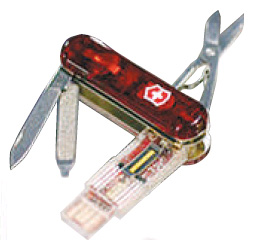Sun

Wrap920AV, Vuzix Corp.
1. Clickfree Transformer Cable, Storage Appliance Corp., $ 60
The backup experts at Storage Appliance have just released another handy device for ensuring you don’t lose all that important data when your computer suffers a breakdown — or is stolen. The Transformer USB cable turns an external hard drive into a Clickfree automatic backup. Since it works with any external hard drive, including ones from Clickfree competitors, it saves a lot of time and trouble in setting up backup software to do the job. Plug it into your computer, connect the external hard drive and it will search, organize and back up PC data and files. www. clickfree. com.
2. Wrap920AV, Vuzix Corp.
Are they sunglasses? Or is it big-screen viewing? Both, according to Vuzix, which has combined the projection of a virtual 60-inch screen ( as viewed from close to three metres) with a pair of sunglasses. With optional 6-Degree of Freedom tracking sensor and optional stereo/ camera pair to combine virtual reality with reality — as in taking a tour of New York City accompanied by an animated tour guide. Compatible with a range of devices from all iPod and iPhone models with video output, to portable media players, video cameras, cellphones with video output, DVD players, PCs and laptops with S-video and others. Available starting in spring of this year. www. vuzix. com.
3. Psyko 5.1 Surround Sound Headphones, Psyko Audio Labs Inc. $ 300
This Calgary company has walked away with honours at this year’s Consumer Electronics Show for Best of Innovations Design and Engineering in the headphone category. The difference, says Psyko Audio CEO James Hildebrandt, is that his company’s technology delivers every sound to both ears instead of delivering left sounds to the left ear and right sounds to the right. The headphones, scheduled to be available early this year are promising to deliver gamers a new surround-sound experience. ww. psykoaudio. com.
4. Zoom H4n handheld recorder, Zoom
Another CES launch, Zoom’s H4n is the next generation and billed as the company’s most sophisticated handheld recorder yet. Built-in X/ Y stereo condenser mics allow variable recording patterns at either 90 degrees or 120 degrees. Incorporates popular features from the H2 including Broadcast Wave Format, compatible time stamp and track market functions and auto-record and prerecord features. Comes with a one gig SD card, wind screen, microphone clip adapter, AC adapter, USB cable, protective case and Cubase LE recording software, with remote control an optional extra. Read more at www. samsontech. com, the U. S. distributor.









